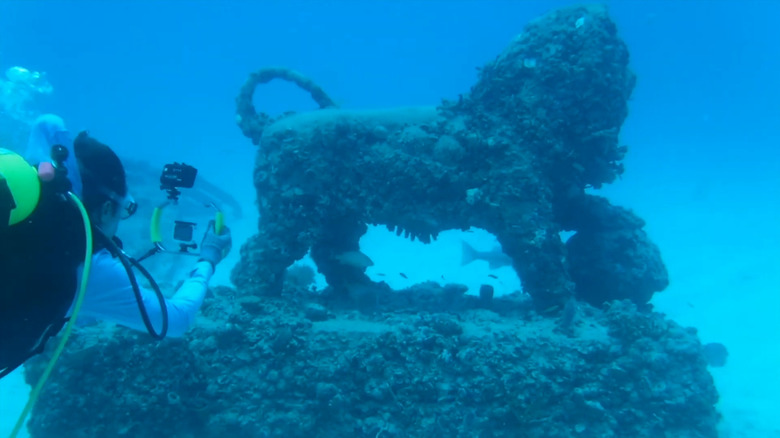Florida Is Home To The Only Underwater Cemetery In The World And It's Completely Free To Visit
Only three miles from Florida's balmy Miami Beach and deep below the blue waves is Neptune Memorial Reef. This place might look like the ruins of an ancient underwater city on the ocean floor, but in reality, it serves two vital functions: It's a thriving ecosystem for underwater life and a final resting place for the dead. This place stretches over 16 acres and may one day be the largest man-made reef in the world, supporting the sea creatures that live in these waters. Colorful fish swim between sculptures of seashells, mermaids, and manatees inscribed with memorial messages honoring those who have had their ashes incorporated into this unique place.
If having a cemetery on the seafloor seems unusual, that's because it is. In fact, for now, it's the only one of its kind. If you want to visit it for yourself, whether to pay tribute to those who have been laid to rest there, to see the fish that have taken up residence in the artificial reef, or just to explore a truly one of a kind location, you can get on your scuba gear and pay it a visit anytime, for free.
An environmentally friendly work of art under the sea
If you're looking for a dive site like no other, you'll love exploring the Neptune Memorial Reef. Exploring this cemetery feels more like finding the lost city of Atlantis just off the coast of Miami Beach. This sculpture garden was designed by Florida artist Kim Brandell, who is better known for his copper sculptures seen in high end hotels and casinos. Swimming between its columns and seeing the big lion sculptures would be enough of a draw, but its living inhabitants, like parrotfish, angelfish, stingrays, lobsters, and pufferfish, are just as beautiful. You might even see a shark while you're scuba diving — but don't worry, they're probably just friendly nurse sharks.
If you love the oceans, this is the perfect place to visit. The Neptune Memorial Reef is considered an environmentally friendly project by organizations like NOAA and the Florida Fish and Wildlife Conservation Committee, so you can explore guilt-free. While modern burials and embalming fluids release toxic chemicals into the earth, this fascinating alternative involves mixing cremains into concrete and using that concrete to create unique pieces of art that become a habitat for fish and other forms of aquatic life, sheltering them and helping to grow their population. Just make sure that you know how to snorkel and scuba dive safely so that you don't disturb the thousands of fish that live in and around the reef.
How you can see Neptune Memorial Reef for yourself
For something that feels so much like a hidden city at the bottom of the sea, Neptune Memorial Reef is remarkably easy to visit. As long as you swim with care out of respect for both the living and the dead at the reef, visiting the reef is encouraged, and open to all. Divers aren't charged for exploring it, and if you have a boat of your own you can easily take it out to the reef without spending a dime. Just be aware that you need to use a buoy, not an anchor, to avoid damaging the reef.
If you don't have access to a boat, it's easy enough to charter one. Neptune Memorial Reef recommends either Diver's Paradise or Tarpoon Lagoon, both of which operate in the area and can take you directly to the reef (though you'll have to dive down yourself). If you don't mind exploring with other divers, you can save money on a private charter by joining a public trip. These boats bring groups to the reef several times a week. If you're new to diving, make sure to check out our beginner's guide to scuba diving like a professional to make sure that you're ready to explore the reef.

